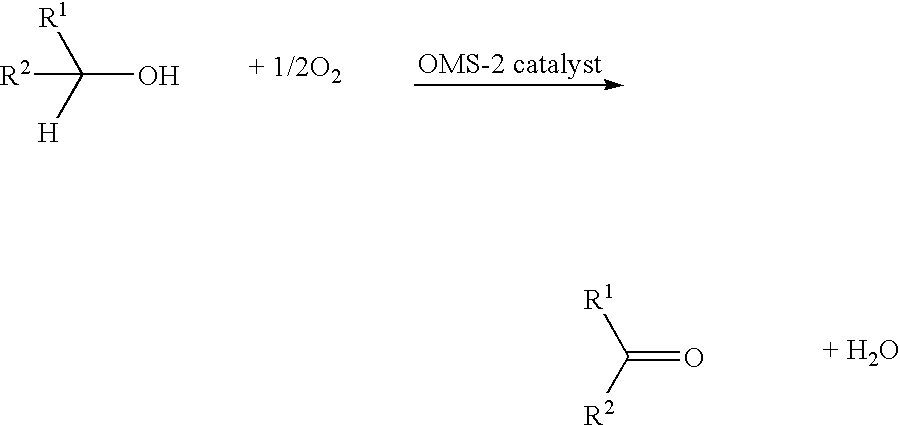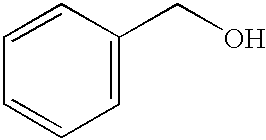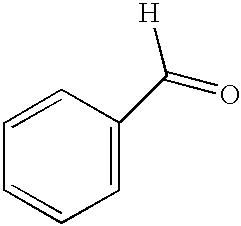Catalytic oxidation of alcohols using manganese oxides
a technology of alcohol and manganese oxide, which is applied in the preparation of carbonyl compounds, organic chemistry, chemistry apparatus and processes, etc., can solve the problems of toxic waste, large amounts of non-reusable, inconsistent reactivity of active manganese oxide,
- Summary
- Abstract
- Description
- Claims
- Application Information
AI Technical Summary
Problems solved by technology
Method used
Image
Examples
example 1
[0055] A typical procedure for the alcohol oxidation reaction is as follows: toluene (10 mL) and the alcohols (1 mmol) were first added to a 50-mL round-bottomed flask containing 0.05 g of the octahedral manganese oxide molecular sieve catalyst (about 0.5 eq, wherein one manganese is considered as one active site). The mixture was then stirred under reflux (110.degree. C.) in air. After 4 hours, the reaction mixture was cooled, the catalyst was removed by filtration, and the filtrate was analyzed using GC / MS, .sup.1H NMR, and IR. The GC-MS analyses were done using a HP 5890 series II chromatograph with a thermal conductivity detector coupled with a HP 5970 mass selective detector. The column used was a HP-1 (cross-linked methyl siloxane) with dimensions of 12.5 m.times.0.2 m.times.0.33-micrometer film thickness.
example 2
[0056] Table 1 below illustrates the percent conversion of various alcohols oxidized by octahedral manganese oxide molecular sieve catalysts at 110.degree. C. under toluene reflux in air for 4 hours using the above procedure. The selectivity of all oxidation reactions was 100%. Percent conversion was measured by gas chromatography and .sup.1H NMR using an internal standard.
1TABLE 1 Entry Substrate Product Catalyst Conversion (%) 1 2 3 K-OMS-2 H-K-OMS-2 90 97 2 4 5 K-OMS-2 H-K-OMS-2 93 99 3 6 7 K-OMS-2 H-K-OMS-2 95 99 4 8 9 K-OMS-2 H-K-OMS-2 50 95 5 10 11 K-OMS-2 H-K-OMS-2 40 100 6 12 13 K-OMS-2 H-K-OMS-2 35 100 7 14 15 K-OMS-2 H-K-OMS-2 5 95 8 16 17 K-OMS-2 H-K-OMS-2 30 90 9 18 19 K-OMS-2 H-K-OMS-2 35.sup.[a] 67[a] .sup.[a]Reaction time was 20 hours.
example 3
[0057] This example illustrates the oxidation of benzyl alcohol using conventional thermal heating and microwave heating. Benzyl alcohol was oxidized using K-OMS-2 catalyst using the procedure of Example 3 without stirring, except that the reaction mixture was heated for only 10 minutes. A 38% conversion of starting material with 100% selectivity was achieved. The same reactants were heated via microwave for 10 minutes with temperature controlled to 110.degree. C., achieving a 58% conversion of starting material with 100% selectivity. This examples shows that microwave heating can be used to reduce reaction times without sacrificing selectivity.
PUM
| Property | Measurement | Unit |
|---|---|---|
| temperature | aaaaa | aaaaa |
| pressures | aaaaa | aaaaa |
| temperatures | aaaaa | aaaaa |
Abstract
Description
Claims
Application Information
 Login to View More
Login to View More - R&D
- Intellectual Property
- Life Sciences
- Materials
- Tech Scout
- Unparalleled Data Quality
- Higher Quality Content
- 60% Fewer Hallucinations
Browse by: Latest US Patents, China's latest patents, Technical Efficacy Thesaurus, Application Domain, Technology Topic, Popular Technical Reports.
© 2025 PatSnap. All rights reserved.Legal|Privacy policy|Modern Slavery Act Transparency Statement|Sitemap|About US| Contact US: help@patsnap.com



